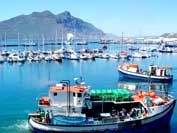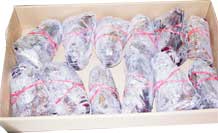Going back in time when Jan van Riebeeck landed in Hout Bay in 1657 he and his men were trading with the local Khoi population tobacco, copper and what else was in demand, for cattle and other livestock.
The Khoisan became Hout Bay’s first commercial fishermen. Some of today’s population living at Hangberg claim to be their descendants. Crayfish up to mid 19th century were mainly used for bait and still today some fishermen when angling the Hottentot fish are applying the very same method.
| |
Discharge
from Vessel
 |
|

Vessels leaving the peer of the Hout Bay harbour after offloading |
The lobster bins are offloaded from the boat and transported to the factory. Should they arrive from a remote area than they are transported in a refrigerated truck. This is to maintain a temperature of 7-12 degrees.
|
| |
Weighting
 |
|
The Marine and Coastal Management (MCM) officials are controlling the weight and monitoring the process.
|
| |
Transfer
to Tank
 |
|
The tanks are filled with seawater maintaining a temperature of 8 degrees Celsius. The total tank capacity can hold 15 tons divided into 27 units. One unit hold up to 300kg representing 800 – 1200 lobsters. The lobsters will remain in the tanks for 72 hours.
|
| |
Sorting
 |
|
The lobsters are than graded whereby they are sorted into various sizes, which ranges are:
180-220gr
220-300gr
300-400gr
400-500gr
500-600gr
600gr+
Generally they are all earmarked for export with the exception of those showing damages, e.g. missing leg, etc; resulting in 3-4% sold locally.
|
| |
Tanks
 |
|
To complete the purging process the lobsters have to be retained in the tanks for 3-5 days.
|
 |
Weighting
 |
|
Fresh lobsters are in for a weighting process before -> Packing.
For frozen, whole and tailed lobsters -> Drowning.
|
 |
Drowning
 |
|
The drowning in fresh, running water will take up to 30 minutes.
|
 |
Tailing
 |
|
After the drowning process is completed the lobster tail is removed from its body.
|
 |
Grading
 |
|
The next grading process sorts the tails into three different sizes.
|
 |
Curling
 |
|

Raw frozen lobsters
|
The lobster are wrapped in plastic and kept together with a rubber band. This applies to the tailed and whole lobsters. |
 |
Packing
 |
|
Live lobsters are chilled for 15 minutes before they are packed. Packing applies according the grading results.
|
| |
Master
 |
|
The process of packing the product into cartons is called "Master". Live lobsters are packed in 10kg or 14kg styrofoam boxes, representing 20-62 units packed in wood wool with an ice pack per box, scaled for weight and labeled accordingly. A sample accompanies the export lobsters to be tested for quality purposes.
Frozen lobster are packed in 5kg boxes, representing +/- 60 tails or 20 whole lobsters per box.
|
| |
Holding Room
 |
|
Keeping the temperature of 7-10 degrees for fresh and -25 degrees celsius for raw frozen lobsters. |

